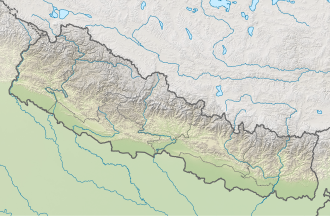| Dorje Lhakpa | |
|---|---|
 Dorje Lhakpa seen from Dulalthok. Loenpo Gang is visible further right. | |
| Highest point | |
| Elevation | 6,966 m (22,854 ft) [1] [2] |
| Prominence | 756 m (2,480 ft) [3] |
| Listing | Mountains of Nepal |
| Coordinates | 28°10′26″N85°46′52″E / 28.17389°N 85.78111°E [2] |
| Geography | |
| Country | Nepal |
| Province | Bagmati [2] |
| Protected area | Langtang National Park |
| Parent range | Jugal Himal [2] |
| Climbing | |
| First ascent | 16 October 1981 [2] |
| Easiest route | West Ridge |
Dorje Lhakpa is a mountain in the Jugal Himal, southeast of Langtang valley in Nepal. [1]
Contents
Visible also from Kathmandu valley it has an elegant pyramid-shaped figure and is an ideal target for photographers and mountaineers. Considered by many of intermediate difficulty with easiest route from the west ridge. Its climb is offered by many trekking and mountaineering agencies in Nepal.

